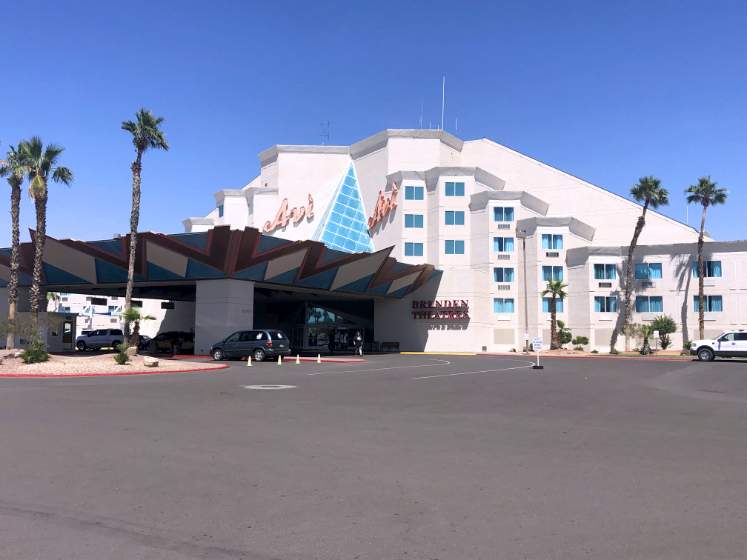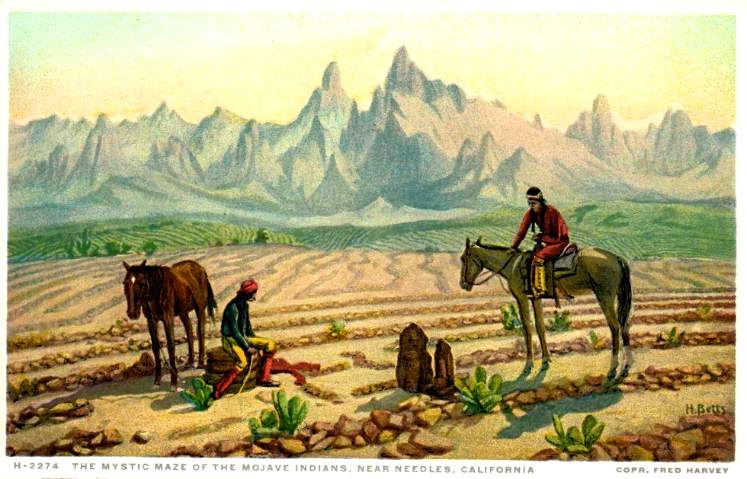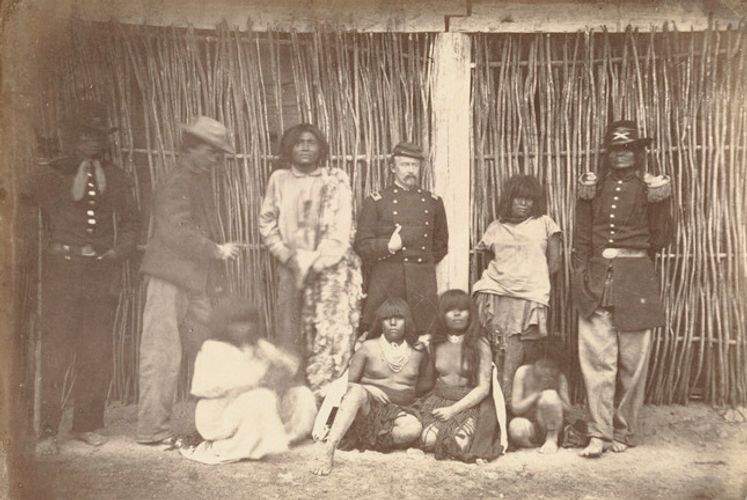
Fort Mojave Indian Reservation

Avi Resort & Casino. Opened on February 17, 1995. Theme: Native American.

Avi Resort & Casino is located at 10000 Aha Macav Parkway on the Fort Mojave Indian Reservation.

Topock Maze. Listed on the National Register of Historic Places in 1978.
"The Mysic Maze was constructed by the Mojave Indians and forms a part of their religious beliefs. The doctrine is that the souls of the departed members of the tribe enter the Maze and wander through it in search of the happy hunting grounds; the good souls succeed in solving the riddle and reach the goal; those other souls wander aimlessly and endlessly, and are at the mercy of the Evil One." (postcard)

"In first times, there was chaos, and from the union of earth and sky was born the Great Spirit Matavilya.
Before he could teach his people all they needed to know about their world, he was killed by his sister, Frog Woman. It was then that his little brother Mastamho took charge of the world and of the people. There were only people then, no animals, birds or fish. Mastamho had to teach the people everything about living, for they knew nothing, not even that they were hungry, thirsty or cold.
He drove a willow stick into the ground and drew out the water that became the Colorado River, and with the river came fish and ducks. Mastamho made the mountains on both sides of the river using the mud of its banks. He planted seeds of melon, corn, pumpkin and beans in the overflow, so the people would have food to eat.
He taught them to build fire when they were cold, and a shade from the sun when they were hot. He showed them how to count. He taught them about the four directions, about the food they grew, and he showed them how to make pottery vessels in which they could cook and store the food. He made the animals and insects and birds, and he gave the people the names for all things.
Mastamho gave the people the river and everything along the river. Whatever grew there was theirs, as he said, and they were the Aha Macave, the Mojave, the people who live along the water.
For the Aha Macave, the river was the center of existence. They practiced a dry farming method, relying on the regular overflow of the Colorado River to irrigate crops planted along the banks. They supplemented this with wild seeds and roots, especially mesquite beans, game and fish taken from the river with traps and nets.
The Mojave could be a fierce people, willing to protect their land and traveling to the pacific coast as proficient traders, where they exchanged with coastal tribes their surplus crops for goods they desired and valued, such as shells.
And back along the banks of the river, they made pottery from sedimentary clay and crushed sandstone, creating cooking utensils and pottery dolls for the children.
The art of tattooing was important to the Mojave. They tattooed their faces with lines and dots - a cosmetic, fashionable practice.
And at death, the Mojaves used cremation to enter the spirit world. The property and belongings of the deceased were placed on a funeral pyres along with the body, to accompany the spirit. Mourners often contributed their own valuable as a showing of love. The names of the dead were never again spoken.
Aha Macave and then the white man came
Sometimes friendly, sometimes deadly. That described the early contact between the Mojave and the white man.
The search for fortune was what brought the white man to the land of the Mojave. A 1604 expedition in search of silver led New Mexico Governor Don Juan Onate through Mojave territory, but it wasn't until December 1775 that Fray Francisco Garces became the first white man to meet the Mojave. His writings reveal the Mojave as friendly. He comments that "The female sex is the most comely along the river, the males very healthy and robust." The men walked naked, the women wore rabbit and beaver skin capes. He called them Jamajab.
American mountain men led by Jedediah Smith appeared in Mojave territory in 1826, and though the Mojave welcomed the trappers, death and hatred loomed in the future of the two groups.
The Mojave believed all living things belonged where they were placed, so it was hard to understand why the trappers were so brutal, throwing beaver carcasses on the river bank after skinning the animals. Subsequent encounters also ended in violence.
In 1911, by Executive Order, the Fort Mojaves were granted a reservation consisting of the old military reserve, areas called the Hay and Wood Reserves on the California and Nevada side of the Colorado River, and adjacent checkerboard land on the Arizona side, a total of 32,000 acres. The checkerboard arrangement came about because the government gave the railroad every other section of land.
The Boarding School closed in 1931, and children began attending public school in Needles.
The traditional leadership structure was changed forever in 1957 with the approval of the Fort Mojave Tribal Constitution, and with it the creation of a seven member Tribal Council."
(Fort Mojave Tribe - Avi Resort & Casino)
"Before you lies the AhaMakav Valley. On this their aboriginal land, the AhaMakav have lived since time immemorial. Here they began. Here they still live. Here they will always remain. This is the land of the AhaMakav, Mojave Nation, People of the Colorado River.
As you look across the valley, you will note the Colorado River wending its way through the length of the land just as it has for centuries. Visualize, if you will, this once wild and mighty river at that long ago time flowing miles wide. Subsistence depended to a large degree upon agriculture. When high water receded, the people did their planting. Surplus was stored to provide for the winter months.
At the northernmost part of the valley stands the spiritual mountain of Avi-Kwa-Ame, from when the AhaMakav received the instructions of life in "The First Time."
Here, upon this land where you now stand, is the Topock Maze; indeed, a cultural site of much importance to the tribe. To this site the AhaMakav warriors returning from battle first paused for purification before continuing home.
We ask that you respect the context of the above interpretation, just as we respect the religions and monuments of deep meaning and importance to others. Thank you."
(AhaMakav Cultural Society, Makav Elders Group, AhaMakav, Mojave Nation)
"On the Havasu National Wildlife Refuge, hundreds of archeological sites confirm the presence of ancestral Native Americans in the Colorado River Valley. Among these sites is the Topock Maze, an earth figure or "geoglyph" in the desert pavement.
Not a true maze, this site is a series of windrows carefully placed in an extensive geometric pattern. Today the site covers about 10 acres. Evidence suggests that it may have originally been only one section in a group of nearby earth images and features. Sadly, important parts of the complex were destroyed by the construction of the highway. But whether or not the geoglyphs in this vicinity were associated with one another, this was clearly an area of symbolic and ritual significance.
The age of the Topock Maze is not known. Other earth figures in this region are believed to be several hundred years old, and some possibly are older. Rare and unique expressions of Native American culture and religion, they remain an enigma of the lower Colorado River desert.
Topock Maze is listed on the National Register of Historic Places."
(U.S. Fish and Wildlife Service, Havasu National Wildlife Refuge)
Located near the Colorado River within the adjacent states of Arizona, California, and Nevada.